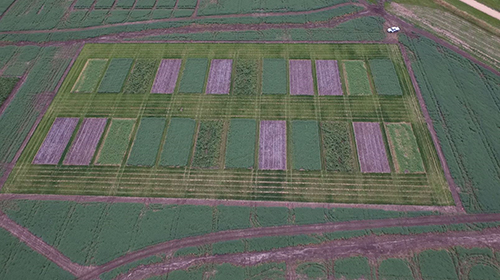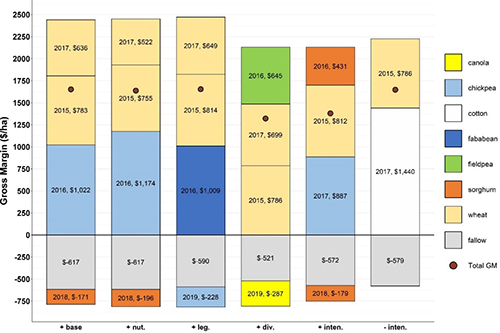Since 2014 the NSW DPI have been investigating the productivity of a number of different farming systems at Nowley research farm run by Sydney University and despite some difficult seasons have come up with some interesting results. Nowley is located near Spring Ridge on the Liverpool Plains which is one the most productive grain growing areas in Australia. This work was part of a farming systems project funded by NSW DPI, QDAF, CSIRO and the GRDC.
Six different farming systems were investigated. These included:
Baseline - this system, based on local commercial practice using wheat/barley, sorghum and chickpea and planting when stored soil moisture was at least 50% of plant available water capacity (PAWC).
Higher nutrient – similar to the baseline system with higher nitrogen application to target greater yield and additional phosphorus (P) to replace that removed in grain.
Higher crop intensity – planting trigger is lower (30% PAWC) to increase the possibility of opportunity cropping. Crops included wheat/fallow/sorghum/double-cropped chickpea planting and fertilized for an average yield.
Higher crop diversity – use a greater range of crops, wheat, durum, barley, chickpeas, field pea, fababean, canola, mustard, sorghum, maize, sunflowers, mungbeans and cotton. Crops choice involved resistance to root lesion nematode and rotation of herbicide modes of action. Crops were planted on at least moderate soil moisture.
Higher legume - involved wheat, durum, barley, chickpeas, faba beans, fieldpeas and mungbeans with one in every two crops being a legume, crops were planted on at least 50% moisture profile.
Lower crop intensity – higher value crops wheat, barley, chickpea, sorghum or cotton are targeted and planted when the moisture profile is greater than 80% full.
The trials used full no-tillage and starter nitrogen (N) and phosphorus (P) were used according to the cropping strategy. Crops were established with disk planters and varieties of appropriate maturity were chosen for the planting window. In-crop herbicides and insecticides were applied according to established industry thresholds and practice.

Rainfall was below average throughout the trial period except for late rains in the winter 2016 season and a severe storm in March 2017. Temperatures also departed from the average including some severe frosts in June and July 2017.
Key findings
In analysing the results, the performance of the various systems were measured in two ways, total tonnage of grain and lint combined produced by each system and the total gross margin in terms of dollars per hectare over the trial period. Average grain and cotton prices over a ten year period minus grading and delivery costs were used to calculate income. Costs were calculated from inputs used in each trial system and prices quoted from one rural merchandiser in Toowoomba.
- The top performing systems were the baseline, high nutrient and high legume system ($1637/ha to $1654/ha). The lower crop intensity system produced less total product but a relatively high gross margin ($1648/ha) due in part to a good 2017 cotton crop and no negative gross margin crops. Increasing crop diversity and crop intensity lowered gross margins by $331 and $273 respectively compared to the baseline system. A sorghum crop failure in the dry 2018 counted against the high intensity system.
- The systems utilizing legumes required slightly less N fertilser and exported more N in grain than non-legume systems, they also maintained higher levels of soil N compared to the baseline system.
- The high nutrient system cost only an extra $15/ha in extra fertiliser but resulted in an extra 46 kg/ha of nitrogen remaining in the soil at the end of the trial (December 2019) for use by future crops. This is reassuring as the extra N applied in this system did not significantly increase yields (possibly due to dry weather).
- All systems particularly those involving legumes are removing significant amounts of Potassium 34 –73kg/ha which may impact the long-term sustainability of cropping.
- Short fallows (four to eight months) out of wheat captured and stored more moisture than short fallows out of pulses (due to the slower breakdown of crop residue) and also more than longer fallows.
Individual crop and overall total gross margins ($/ha) of the six farming systems at Nowley between 2015 and 2019.







